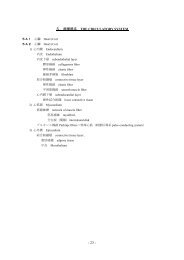Program / Abstract Book - KMU WWW3 Server for Education ...
Program / Abstract Book - KMU WWW3 Server for Education ...
Program / Abstract Book - KMU WWW3 Server for Education ...
Create successful ePaper yourself
Turn your PDF publications into a flip-book with our unique Google optimized e-Paper software.
No. 45 (PH 11)<br />
T-cell Acute Lymphoblastic Leukemia with Chromosomal Rearrangements<br />
Involving the Immunoglobulin Heavy Chain Breakpoint at Band 14q32<br />
Joonhong Park 1 , Myungshin Kim 1 , Jihyang Lim 1 , Yonggoo Kim 1 , Kyungja Han 1 , and Seok Lee 2<br />
Department of Laboratory Medicine 1 , Division of Hematology 2 , Department of Internal Medicine, The<br />
Catholic University of Korea, Seoul, Korea<br />
T-cell acute lymphoblastic leukemia (T-ALL), a malignant proliferation of T-lymphoid blasts, represents<br />
15% of acute lymphoblastic leukemia. In contrast with B-cell ALL, patients with T-ALL have different<br />
chromosomal abnormalities and appear to have an unfavorable prognosis, leading to more intensive<br />
treatment. Chromosomal rearrangements in T-ALL usually involve breakpoints in bands where the<br />
T-cell receptor (TCR) genes are located; these are bands 14q11 (TCR-α and -δ genes), 7q32-36<br />
(TCR-βgene), and 7p15 (TCR-γ gene). Other chromosomal changes, specific or not of T-ALL, have also<br />
been observed. We report T-ALL with t(8;14)(q24.1;q32) similar to that seen in Burkett’s lymphoma.<br />
Flow cytometric analysis of bone marrow revealed CD2, CD3, CD7, cytoplasmic CD3, CD34, HLA-DR,<br />
CD13, and CD117. The phenotype was suggestive of T-ALL. RT-PCR screening <strong>for</strong> leukemia-related<br />
fusion transcripts (HemaVision; Bio-Rad Laboratories, CA) was negative. Mitoses were obtained only<br />
from spontaneously dividing cells in the absence of mitogens; 25 of the 30 metaphases analyzed were<br />
chromosomally abnormal and had a der(14)t(8;14)(q24.1;q32). Disruption of the MYC gene which<br />
resulted in a one fusion, one green, and one orange signal pattern was detected by MYC dual-color<br />
break-apart probe (Abbott Molecular, IL) PCR-based B-cell and T-cell clonality (Ig and TCR gene<br />
rearrangement) assays was studied by the BIOMED-2 multiplex Ig/TCRB PCR assay (InVivoScribe,<br />
CA) but did not detected any clonal immunoglobulin and TCR rearrangements. Although abnormalities<br />
involving 14q32 are characteristic of B cell disorders, they have also been described in T cell<br />
malignancies, suggesting that genes transcribed in T cells and/or oncogenic sequences significant in T<br />
cell neoplasia are present in 14q32.<br />
- 98 -



